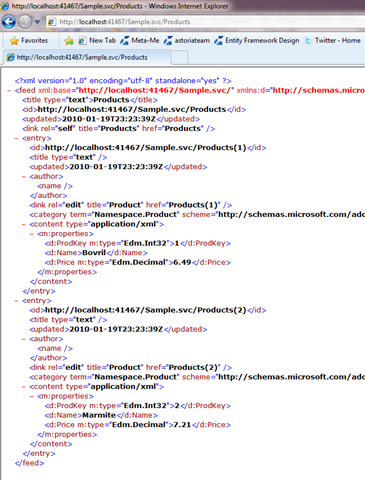完整教程目录请参见:《自定义Data Service Providers — 简介》
在上面的章节中,我们挂接了自定义的服务提供者,并且实现了IDataServiceQueryProvider接口,虽然他只能用来查询元数据和服务契约。
在这一部分,我们让查询也可以运行起来,要做到这点我们必须知道数据从哪里来:数据源,以及我们必须实现IDataServiceQueryProvider接口。
创建数据源
那么我们的Product数据在那么找到呢?
我们先假设数据是放在内存里面,这样实现比较简单。现在我们第一步先编写一个基类:
public abstract class DSPContext
{
public abstract IQueryable GetQueryable(ResourceSet set);
}
然后我们设计一个仅能处理Products数据的强类型类,看起来像这样:
public class ProductsContext: DSPContext
{
private List<Product> _products = new List<Product>();
public override IQueryable GetQueryable(ResourceSet set)
{
if (set.Name == "Products") return Products.AsQueryable();
throw new NotSupportedException(
string.Format("{0} 未找到", set.Name)
);
}
public List<Product> Products
{
get {
return _products;
}
}
}
到目前还是蛮简单的,你应该明白其ResourceSet背后的数据源就是一个简单的List。
这里需要注意的是,由于我们的数据放在内存里,所以我们这里使用了LINQ to Objects技术提供的.AsQueryable()方法实现IQueryable的返回值。
接下来,我们需要修改我们的Sample服务类,他使用ProductsContext作为数据源。
public class Sample : DSPDataService<ProductsContext>
{
我们还需要重载这个类的CreateDataSource方法,以便预先加入一些测试数据进去。
protected override ProductsContext CreateDataSource()
{
ProductsContext context = new ProductsContext();
context.Products.Add(
new Product {
ProdKey = 1,
Name = "Bovril",
Cost = 4.35M,
Price = 6.49M
});
context.Products.Add(
new Product {
ProdKey = 2,
Name = "Marmite",
Cost = 4.97M,
Price = 7.21M
});
return context;
}
最后一步,我们需要完成GetQueryProvider方法(需要参见前面教程中Sample类的代码,那个时候我们填写的是Object,而不是下面的ProductsContext)。
public override IDataServiceQueryProvider GetQueryProvider(
IDataServiceMetadataProvider metadata)
{
return new DSPQueryProvider<ProductsContext>(metadata);
}
为强类型数据实现IDataServiceQueryProvider
现在,我们需要重新编写上个教程章节中编写的DSPQueryProvider<T>类,当时那个类很多功能都没有实现。
而我们现在需要实现一个对内存中强类型类数据的查询提供者,这里所说的“强类型类”是指:使用ResourceType描述类型信息并且其描述的属性都能够找到真实的CLR属性与之对应。
代码如下:
public class DSPQueryProvider<T> : IDataServiceQueryProvider where T : DSPContext
{
T _currentDataSource;
IDataServiceMetadataProvider _metadata;
public DSPQueryProvider(IDataServiceMetadataProvider metadata)
{
_metadata = metadata;
}
public object CurrentDataSource
{
get { return _currentDataSource;}
set { _currentDataSource = value as T; }
}
public IQueryable GetQueryRootForResourceSet(
ResourceSet resourceSet)
{
return _currentDataSource.GetQueryable(resourceSet);
}
public ResourceType GetResourceType(object target)
{
Type type = target.GetType();
return _metadata.Types
.Single(t => t.InstanceType == type);
}
public bool IsNullPropagationRequired
{
get {return true; }
}
public object GetOpenPropertyValue(
object target,
string propertyName)
{
throw new NotImplementedException();
}
public IEnumerable<KeyValuePair<string, object>> GetOpenPropertyValues(object target)
{
throw new NotImplementedException();
}
public object GetPropertyValue(
object target,
ResourceProperty resourceProperty)
{
throw new NotImplementedException();
}
public object InvokeServiceOperation(
ServiceOperation serviceOperation,
object[] parameters)
{
throw new NotImplementedException();
}
}
实现说明
在上面的实现中,CurrentDataSource内部使用_currentDataSource变量记录,其最终运行时指向ProductsContext的实例。
在下面的GetQueryRootForResourceSet方法中,我们使用了_currentDataSource.GetQueryable()方法返回特定ResourcceSet(资源集)的查询对象(IQueryable)。
我们还实现了GetResourceType(object)方法,他首先获取Target的CLR类型,然后在IDataServiceMetadataProvider.Types中使用InstanceType查找与之匹配的类型。
最后,IsNullPropagationRequired属性返回了true,因为我们必须让Data Services处理LINQ to Objects无法处理的null。
什么是NullPropagation
让我们来看看一个LINQ的查询例子:
var results = from x in queryRoot
select x.Customer.Name;
在这个例子里,如果x.Customer是null值,那么程序运行时将抛出NullReferenceException异常。
可以在上面的IsNullPropagationRequired属性实现中返回true,这样Data Services就会检查查询的数据是否是null从而防止出错。
注意:诸如LINQ to SQL和LINQ to Entity 这样的IQueryables数据库查询实现,是支持null值传播的,无须返回true。
哪些是未实现的
由于我们的Data Service Provider是针对强类型实体实现的,所以Data Services永远不会调用GetPropertyValue方法,因为默认情况下系统直接从实例的属性上读取。
译者注:可以查看一下ResourceProperty类包含CanReflectOnInstanceTypeProperty属性,默认情况下此属性返回true,表示直接使用反射获取值(实际上使用了Expression.Property加快了访问速度)。
在当前实现的模型中,我们没有支持服务操作(ServiceOperation)、开放类型(OpenType)和开放属性(OpenProperty),所以我们都在对应的方法中抛出了NotImplemented异常。
总结
最终我们完成了只读方式的数据查询功能,键入:http://localhost/simple.svc/products看起来像这样:

我们还有很长的路要走,在后面的教程中,我们将逐步增加一些功能支持,包括数据更新、关系、服务操作、流、分页和开放类型,以及展现没有对应的CLR类型的情况。